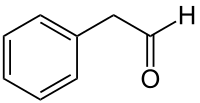Phenylacetaldehyde
 | |
| Names | |
|---|---|
| IUPAC name
2-Phenylacetaldehyde | |
| Other names
Hyacinthin Phenylethanal | |
| Identifiers | |
| 385791 | |
| 122-78-1 | |
| ChemSpider | 13876539 |
| |
| Jmol-3D images | Image |
| PubChem | 998 |
| |
| UNII | U8J5PLW9MR |
| Properties | |
| C8H8O | |
| Molar mass | 120.15 g/mol |
| Appearance | Colorless liquid |
| Density | 1.079 g/mL |
| Melting point | −10 °C (14 °F; 263 K) |
| Boiling point | 195 °C (383 °F; 468 K) |
| 2.210 g/L | |
| Refractive index (nD) |
1.526 |
| Hazards | |
| Main hazards | Harmful, Flammable |
| R-phrases | R22 R36 R37 R38 |
| S-phrases | S26 S36 |
| Flash point | 87 °C (189 °F; 360 K) |
| Related compounds | |
| Related 2-phenyl aldehydes |
3,4-Dihydroxyphenylacetaldehyde |
| Except where noted otherwise, data is given for materials in their standard state (at 25 °C (77 °F), 100 kPa) | |
| | |
| Infobox references | |
Phenylacetaldehyde is an organic compound used in the synthesis of fragrances and polymers.[1]
Natural Occurrence
Phenylacetaldehyde occurs extensively in nature because it can be biosynthetically derived from the amino acid phenylalanine. Natural sources of the compound include chocolate,[2] buckwheat,[3] flowers, and communication pheromones from various insect orders.[4]
Uses
Fragrances and flavors
The aroma of pure substance can be described as honey-like, sweet, rose, green, grassy and is added to fragrances to impart hyacinth, narcissi, or rose nuances.[1] For similar reasons the compound can sometimes be found in flavored cigarettes and beverages.
Historically, before biotechnology approaches were developed, phenylacetaldehyde was also used to produce phenylalanine via the Strecker reaction as a step in the production of aspartame sweetener.[1]
Polymers
Phenylacetaldehyde is used in the synthesis of polyesters where it serves as a rate-controlling additive during polymerization.[1]
Natural Medicine
Phenylacetaldehyde is responsible for the antibiotic activity of maggot therapy.[5]
Preparation
Phenylacetaldehyde can be obtained via various synthetic routes and precursors. Notable examples include:
- Isomerization of styrene oxide.[1]
- Dehydrogenation of 2-Phenylethanol over silver or gold catalysts.
- Darzens reaction between benzaldehyde and chloroacetate esters.
- Direct oxidation of styrene in the presence of palladium salts and copper(II) chloride.
- Hofmann rearrangement of Cinnamamide (aka (2E)-3-Phenylacrylamide).[6][7]
- Oxidation of Cyclooctatetraene with aqueous Mercury(II) sulfate.[8][9]
- Strecker degradation of phenylalanine.[10]
Reactivity
Phenylacetaldehyde is often contaminated with polystyrene oxide polymer because of the especial lability of the benzylic alpha proton and the reactivity of the aldehyde. Aldol condensation of the initial dimer gives rise to a range of Michael acceptors and donors.
References
- ↑ 1.0 1.1 1.2 1.3 1.4 Kohlpaintner, Christian; Schulte, Markus; Jürgen, Falbe; Lappe, Peter; Jürgen, Weber; Frey, Guido (2014). "Aldehydes, Araliphatic". Ullmann's Encyclopedia of Industrial Chemistry 1. doi:10.1002/14356007.m01_m03.pub2. ISBN 9783527334773.
- ↑ Schnermann, Petra; Schieberle, Peter (1997). "Evaluation of Key Odorants in Milk Chocolate and Cocoa Mass by Aroma Extract Dilution Analyses". Journal of Agricultural and Food Chemistry 45 (3): 867–872. doi:10.1021/jf960670h.
- ↑ Janes D, Kantar D, Kreft S, Prosen H (2009). "Identification of buckwheat (Fagopyrum esculentum Moench) aroma compounds with GC-MS". Food Chemistry 112 (1): 120–124. doi:10.1016/j.foodchem.2008.05.048.
- ↑ El-Sayed, Ashraf. "Semiochemical-2-phenylacetaldehyde". The Pherobase: Database of Insect Pheromones and Semiochemicals. Extensive Database of Insect Pheromones and Semiochemicals. Retrieved 26 November 2014.
- ↑ Pavillard, E.R.; Wright, E. A. (1957). "An Antibiotic from Maggots". Nature 180: 916–917. doi:10.1038/180916b0.
- ↑ Weerman, R.A. (1913). "Einwirkung von Natriumhypochlorit auf Amide ungesättigter Säuren". Justus Liebigs Annalen der Chemie 401 (1): 1–20. doi:10.1002/jlac.19134010102.
- ↑ Adams, Rodger (1946). Organic Reactions Volume III (PDF). Newyork: John Wiley and Sons Inc. pp. 275, 276, & 285. ISBN 9780471005285. Retrieved 15 June 2014.
- ↑ Reppe, Walter; Schlichting, Otto; Klager, Karl; Toepel, Tim (1948). "Cyclisierende Polymerisation von Acetylen I Über Cyclooctatetraen". Justus Liebigs Annalen der Chemie 560 (1): 1–92. doi:10.1002/jlac.19485600102.
- ↑ Kunichika, Sango (1953). "Cyclopolyolefins Derived from Acetylene". Bulletin of the Institute for Chemical Research, Kyoto University 31 (5): 323–335.
- ↑ Schonberg, Alexander; Radwan, Moubacher (1952). "The Strecker Degradation of α-Amino Acids". Chemical Reviews 52 (2): 261-277. doi:10.1021/cr60156a002.